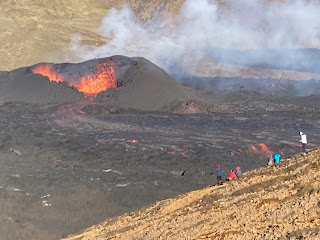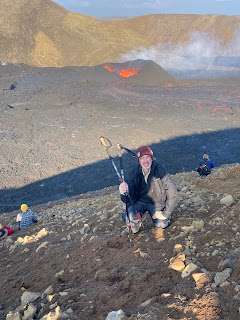Yesterday I was flipping crêpes at my market stand in Baltimore. Then, thanks to the miracle of jet engines, in-flight meal service, and carousels of parading luggage, I was now having a grapefruit at a kitchen table in Iceland. My host’s housekeeper offered up some food a recent guest had left. I ate it. I ate it all. No, I’m not proud. Besides, it was good. Some kind of meat and beans dish. There was bread as well, a kind I hadn’t tried before. I spread some brie and blueberry jam on it and I had something of a meal. We talked while the laundry swished in the kitchen washing machine. I’d only been up for a few hours after a nap of about two hours which I sorely needed when I stumbled into the house this morning, dragging my pack and other gear I’d need for this trip. I was still very tired. I’d come for the famous Laugavegur trek, and I was more than a little trepidatious, not being an experienced camper. Or trekker for that matter. But then, in other news, there was this volcano erupting. I might have to look into that.
“I’ll go to the volcano tomorrow,” I told Reynalda.
“Why don’t you go now?”
It was four in the afternoon, and it’s true that this being the month of August there was still plenty of daylight left. The sun would set around ten o’clock.
I didn’t want to admit that I was tired and a procrastinator to boot. Mostly a procrastinator. And I knew the path from last winter when I’d visited the dead volcano. It was demanding. I took a bite of grapefruit, looked at Reynalda expectantly. Maybe she’d changed her mind. I'd get a "pass" for today.
“Volcano, huh?”
“Yes! Go!”
“Now?”
“Go! Go!”
I got my gear together. I was going to the volcano.
It’s a short drive to the trailhead from the airport town of Keflavik. I mostly remembered the route, knew that I had to head towards Grindavik. To reassure myself I looked for the derelict machinery abandoned at a rock quarry along the coast. Yes, it was still there, no one had moved it. I was on the right track. I stopped in at the N1 station in town, bought a sandwich. I’d loaded up on food back at the guesthouse but I knew the hike would be at least two and half hours each way, with a substantial climb to the top.
I mentioned that I’d been to the trail last winter. I’ve been to Iceland a lot. I don’t want to share how many times because it’s actually a little embarrassing. I’m something of an Iceland addict. I could imagine one of those twelve-step programs where you have to sit and admit you have a problem.
“Hi, I’m Gerrit and I’m addicted to Iceland.”
The other Iceland addicts: “Hi, Gerrit.”
So I’ll keep my number of visits a secret for now. Not going to tell. I’ll leave it up to your imagination. Ok, twenty-one times. I’m starting to know my way around by now.
This time there was a heavy police presence. The Icelandic search and rescue teams were out in full force as well. In January it was calm, not many people wanted to hike to the dormant volcano. Parking was now at a premium, and the landowners around there had set up makeshift parking lots in the wild countryside. It was an amazing sight to see—-rows of cars, hundreds of them. I’d have a lot of company on this hike. Seeing that the first parking area was full to capacity, I drove farther down the road. There was another lot that was quickly filling up. I found a spot and parked. I ate my sandwich in the car, put on my outer rain gear and took my trekking poles out of the back. These make me feel like an experienced outdoorsperson although I’m relatively new to using them. On my practice hikes back home on the Appalacian Trail, the long distance “through-hikers” I met told me I should be using them for the trek I had in mind. I bought a set. I’m glad I did; they help tremendously with balance and minimizing strain on the back and knees. And they make me look like I know what I’m doing.
In January, during my last visit, the weather was ok down below where the trail starts. Just a little cold with some wind. Then up top, in typical Icelandic fashion, frozen stuff started falling from the sky. Freezing rain, sleet,some snow. Just a healthy winter mix. A little of everything. This made for a cold situation, and the footing, which was already treacherous, more slippery. For this trip I put on some outerwear that would fend off rain if Mother Nature decided to pull that stunt again. It turns out the weather was phenomenal, a very unusual thing when describing the weather here. It is often windy with rain that slashes your face. It can be unpleasant, but in a fun kind of way.
The path at the beginning is deceptively easy; it is a wide track with some loose dirt and rock but very easy to negotiate. It continues on like that for some time, then after twenty minutes or so a small mountain looms up ahead. And the trail winds back and forth up the steep incline. It would be necessary to get up and over. No easy way around. It was reminiscent of the famous Knlondike Pass from the days of the Gold Rush. A single line of hikers, one solid string of humanity, struggled up the steep slope.I’d soon be joining them. I’m glad I had my sandwich. . For this part of the hike, it would be accurate to describe the path as a “trail.” That’s what everyone calls it. After getting up and over, the terrain opens up to a jumble of jagged rocks, boulder fields, and more jagged rocks with a variety of different hazards thrown in for good measure. The trail markers at this point are just a general reference to get the hikers going in the right direction. But by now it’s a mad scramble with a wide field of volcano-seekers making their way in a fairly disorganized wave. Think of a concert letting out, and everyone heading back to their cars. It was like that. From time to time I glanced at the markers, which were often some distance from where I was actually walking. For the most part I just followed everyone else. They seemed to know where they were going.
For sheer difficulty of walking, I don’t know which part of the hike I’d choose. The beginning was relatively easy, then after three kilometers or so a whole new landscape of obstacles opens up. It is like warning from nature, the equivalent of no trespassing signs:
KEEP OUT
YOU DON”T BELONG HERE
GO BACK
My trekking poles, while very useful in the more even parts of the hike and the steep climbs, were all but useless in the rocks and small boulders. They’d get jammed in between. I knew it was only a matter of time before one got bent into something I could no longer use. Fortunately they are very light and I was able to tuck both of them under my arm to make faster headway and not get stuck between rocks.
Since the mental concentratrion involved in getting across this torturous terrain is considerable, after some time I forgot why I was actually doing this. But then, there it was. After yet another steep descent over large and rounded rocks, then across a field of randomly-jutting stones, the view gave way to the constant eruption. I didn’t have any expectation or feelings about this beforehand. Would it be fun? Exciting? Spectacular? All of those? I didn’t think about that. I just wanted to get to it in the first place. In trying to choose the right word, I will use one that I think is probably over-used these days. For example, when one have the right change to pay for their purchase, it is not necessarily “awesome.” It might be convenient or fitting. And if one manages to finish all their work by quitting time, I don’t think that is particularly awesome, either. But when you climb over the last hill, and you’re feet are on the edge of a valley simmering with a river of molten lava, and the constant eruption is heaving liquid rock over two-hundred feet in the air, then I think I am justified in using the word “awesome.” So it’s that. And the lava makes a rumbling, churning noise as it roils and boils in defiance of any special effects Hollywood can come up with. It’s better than anything in the world, for the simple reason that it’s what made this world, one of the forces that helped shape our planet. It was a humbling experience, to see this small glimpse of the massive power buried deep within our world.
And it was right there. Another twenty minutes, across the field of fresh and cooling lava, and I’d be standing in front of the volcano. I wouldn’t have survived the trip, however; I’d be burned up by then. At that point there was no safe place to walk. Those of us who’d made the trek were mesmerized by the heaving eruption literally right in front of us. Our valley was steep where it dropped to meet the black and cooling lava. The slow-moving river flowed continuously, seeking new areas to deposit this recently-erupted material. For the lower parts of the hike, these dark fields of lava were present right alongside the path; the lava field was extensive, having been produced by the older eruptions from last year.
I chose a spot on the steep hillside to appreciate this rare scene—one that I would probably never see again. An older couple from Paris was there, and the man had a nice camera that he was taking a photo of his wife with. I told him I’d capture the two of them together if they’d take a photo of me with my phone camera. Otherwise no one would ever believe I’d done this. They’d come to Iceland just for the volcano and were also visiting other areas. I didn’t go into my whole history with the country but explained that this was something of a warmup hike for the big Laugavegur trek I’d be doing later. We left things like that. With a volcano erupting nearby, small talk wasn’t really called for.
 |
| Beginning hike to the volcano |
The hike down was not as strenuous as the climb, but was possibly more treacherous. Many parts were very slippery with loose dirt and rocks. I may as well have been walking on small marbles. I noticed at these places the rescue teams were strategically placed. They were standing by, ready to help if anyone should slip and fall. I had time to listen to the different languages of the other visitors and found that the French, Polish, Americans and of course Icelanders were heavily represented on the hike. Everyone was united in their quest to see the eruption.
As I neared the flatter sections below, I knew I was getting closer to the parking area. I recognized some landmarks. I eagerly scrambled to the large mass of cars parked together out in the wilderness. Looking around, it didn’t seem quite right. I was in the wrong lot.
I’d have to hike another 2-1/2 kilometers to my car.
Oh.













